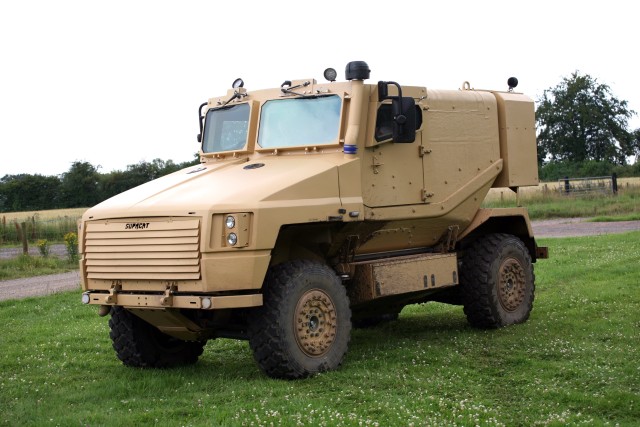Supacat unveils next-generation Protected Vehicle (SPV) Series at DSEi
04-09-2009Supacat unveils its new Supacat Protected Vehicle (SPV) Series at DSEi 2009, 8-11 September, in London. The SPV Series is designed to enhance Supacat’s successful range of high-mobility vehicles.
Supacat is offering the 4×4 SPV400 as the best solution to the UK MoD’s Urgent Operational Requirement (UOR) for a Light Protected Patrol Vehicle (LPPV) to replace the Land Rover Snatch platform.
The SPV design combines a fully integrated protection system with a state-of-the-art automotive solution to provide a LPPV with supreme cross-country performance and the agility to operate in tight urban environments. The protection system comprises a V-shaped hull to provide mine blast protection and a composite crew ‘pod’ to provide both blast and ballistic protection. Developed with NP Aerospace, the protection system includes mine blast seats and configurable ballistic armour to meet specific operational threats.
“Building on our experience and integrating direct feedback from operational use of the existing fleet, the SPV takes the performance of lightweight protected mobility platforms beyond those currently available worldwide,” says Nick Ames, Managing Director of Supacat. “From the outset we have considered the operator’s needs and the integration of modern battlefield systems, making the SPV an attractive and upgradeable solution for 21st century operations.”
SPV survivability is based on ‘fully integrated protection’, in which threat protection measures are integrated into the vehicle structure to achieve an optimised high protection, low weight solution. It uses an armoured steel V-shaped chassis hull, manufactured as a single structure, with high ground standoff to provide integral blast protection. The axle assemblies are mounted in sacrificial sub-frames, fore and aft of the hull, designed to blow off in the event of a wheel mine blast. The composite crew pod sits over the hull, between the wheels, and uses the latest composite and ceramic armour systems to mitigate operational threats at optimal weight. The composite armour systems are designed by NP Aerospace, building on its extensive weight-efficient composite experience.
The SPV chassis design extends the ‘mobility performance’ ethos of previous Supacat vehicles and incorporates all experience from previous platforms. High-articulation independent suspension, air spring units and tuned-for-purpose damping, coupled to managed power transmission, provide all-terrain mobility and speed. A starter-generator provides substantial electrical power for all mission scenarios and the same Cummins engine and Allison transmission system matches the logistic footprint of Jackal and Coyote.
The 4×4 SPV400 Series concept, which carries a 2+4 crew and has a declared gross vehicle weight of 7500kg, allows a payload of 1500kg. A 6×6 SPV600 Series sister platform is due to follow.
Supacat and NP Aerospace offer an innovative and proven design capability in vehicle mobility and protection to deliver the LPPV Programme. They are the leading vehicle UOR providers responsible for the backbone of the UK Armed Forces’ in-theatre protected mobility fleet, respectively supplying and supporting Jackal and Coyote, and Ridgeback and Mastiff. For the LPPV bid Supacat is prime contractor and systems integrator in charge of the mobility platform; and NP Aerospace is principal sub-contractor responsible for the protection and crew pod, as well as manufacturer.
Share this article:

